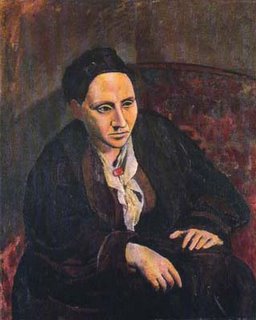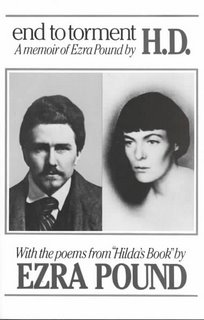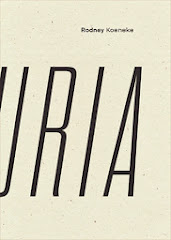I spent my undergraduate years loving/hating Eliot … all I really know is that
The Waste Land is a poem / people say a lot of other things.
Virtually everywhere one looks, as the name Eliot pops up so does the word Modern. Is he the quintessential Modernist … why him … of all that is labeled modern among all that is/was modern why does a three-piece-suited shut down ex-pat hold a movement’s/moment’s trophy. Pedestalled above his contemporaries (save maybe Pound)—the face of between-the-wars poetry.
I must admit, my ideas for this are spawned from an over-dinner conversation w/ Stephen, who pointed me toward “The Aura of Modernism” by Marjorie Perloff … the following sources, however, I dug up on my own.
Perhaps Eliot is held in such esteem because he pushed a text forward—rejecting Modern conventions to create a
Waste Land that holds a much more postmodern ideal [lack of ideals?].
From “Projective Verse” by Charles Olson:
“A poem is energy transferred from where the poet got it (he will have several causations), by way of the poem itself to, all the way over to, the reader. Okay. Then the poem itself must, at all points, be a high energy-construct and, at all points, an energy-discharge.”
The Waste Land is a flux of energy. –Controlled. Regulated. Allowed to move forward & back on itself. A text of interweaving energies—new & recycled—transferred into sounds/linguistics—a seeming mess of semiotics—the heteroglossic confluence of broken down fragments / an anti-epic construct—devalued/revalued into a narrative of interweaving energies.
From
Themes & Variations by John Cage:
“A work should include its environment, is always experimental (unknown in advance).”
“Importance of being perplexed. Unpredictability.”
“Complexity of nature; giving up simplicity of soul, vision, etc.”
“Constellation of ideas (five as a minimum).”
Again, the confluence, the interconnection, the constellation—the dialectics. There is something in
The Waste Land that denies the reader a simple experience. Countless complex themes—ancient Sumerian fertility religious rites meet the pissy rain of soon-to-be bombed out London—a poem of annotations / pages scarred w/ footnotes. No one knows where this poem goes. It goes somewhere new every time it’s read. It leads underneath the narrative—it leads around standard text/language—it leads well beyond the expectations for a “Modern” text.
A happy / self-induced confusion. A poem of words / thoughts / sounds / languages – fuck the references [let the words be the reader’s Tiresias / let Buddha & Tarot cards tell you of the Grail – it only makes sense when you stop looking for it to make sense].
From “To Define” by Robert Creeley:
“A tradition becomes inept when it blocks the necessary conclusion; it says we have felt nothing, it implies others have felt more.”
Eliot fragments worldwide traditions.
The Waste Land steals a little bit of everything / reduces it all down to a minimum / remixes into a hodgepodge of mix-tape poetry [think late 80s/early 90s punk rock/post-punk—mix tapes were for sale on street corners & at shows—90 minutes of different sources / different sounds jammed together into one experience—the tradition redefined / the tradition remade / the tradition fragmented & split up & fused back together into a new starting point].
From “The Rejection of Closure” by Lyn Hejinian:
“I perceive the world as vast and overwhelming; each moment stands under an enormous vertical and horizontal pressure of information, potent with ambiguity, meaning-full, unfixed, and certainly incomplete. What saves this from becoming a vast undifferentiated mass of data and situation is one’s ability to make distinctions. Each written text may act as a distinction, may be a distinction. The experience of feeling overwhelmed by undifferentiated material is like claustrophobia. One feels panicky, closed in. The open text is one which both acknowledges the vastness of the world and is formally differentiating. It is the form that opens it, in that case.”
The Waste Land will suffocate. It is line after line of seemingly undifferentiated data w/o distinction. Hell, it uses as many different languages in cohesion as is poetically possible—& the final trinity of “shantihs” leaves the doors hanging agape for distinction[s]. The poem’s claustrophobic effects [affects?] are within the cave-in of language [the cave-in of languages]. A mess of text / a mess of texts / a mess of data: heteroglossia = a dialectic. There are collisions & aversions—all of which suck out the air in the room & leave a wide-open book of fragments / a wide-open set of individual differentiations. Removing the epic from the epic / removing the meaning behind the tradition / removing denotation from diction / it is up to the reader to refill all that’s been removed.
From “Semblance” by Charles Bernstein:
“Rather than having a single form or shape or idea of the work pop out as you read, the structure itself is pulled into a moebius-like twisting momentum.”
The Waste Land is never singular. Every source to everything is deconstructed / is ripped into a new context of language[s]/sounds. Meaning here, is a product of collage/assemblage work / is subjectively determined by each reader & is subjectively determined upon each reading. For what is here, so much more has been discarded—the ideas / images / poetics employed within are endless & separate from conventional use.
Eliot’s
Waste Land is beyond the scope of hermeneutical analysis/reading. A construct of language & sounds / a construct of tradition & imagery / a construct of constructs—an exercise of language & sound might be more applicable. This is an experiment. This is a cut-up / a collage / an evolution of forms/theories / the appropriation of everything for the sake of something small & complex /
The Waste Land is well beyond what people call Modern. Modernism rejected most everything it revolted against /
The Waste Land rejected everything Modernism still held. A simultaneous inclusion/exclusion / an intentional misprision of all received values and poetic norms / something that if read w/o knowing the poet’s name & the date of composition would be called—w/o hesitation—breathtakingly postmodern.













